Whenever a new (or old) door is installed, a hole must be drilled into the knob (or deadbolt). However, following this tutorial, you don’t have to worry about drilling a new hole in your door for your door knobs.
Using a jig is the easiest way. All the usual suspects – DeWalt, Milwaukee, etc. – have cheaper ones in the $30-$40 range.
The majority of standard applications will be handled by those. You won’t regret it, I promise. However, renting, buying, and reselling may be best if you only want to do one and don’t collect tools.
If you prefer, you can mark the centerlines for both the lock cylinder and the knob on the door using the paper template that came with the lockset.
To bore the hole for the lock cylinder in the door edge, you use a hole saw or a drill attached to a brace and bit. To cut the hole for the knob, you use a large hole saw that is of the appropriate size.
How to Cut a Doorknob Hole?
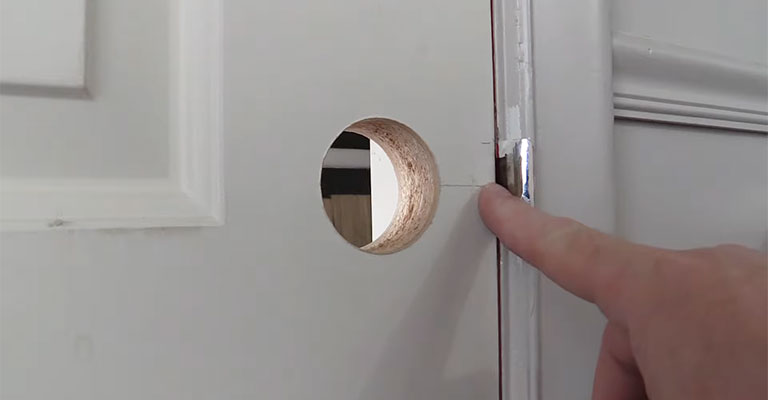
It is necessary to drill two holes into the door to install a doorknob – or a lockset as it is more appropriately known.
There is one for the knobs and the spring-loaded mechanism that turns them and another for the barrel. The jamb must also be made with a hole for the barrel.
In most cases, you can install locksets with a 2 1/8-inch hole saw and a 7/8-inch spade bit since locks have become standardized. You will find a template in your new lockset that makes drilling holes easy.
Things You’ll Need
- Drill
- 2 pc 1/8 inch drill bit
- Lipstick
- Chisel
- Template for locksets
- Tape
- A bit with 1-inch diameter or 7/8-inch spade bit
Step 1: Mark The Centers Of The Holes
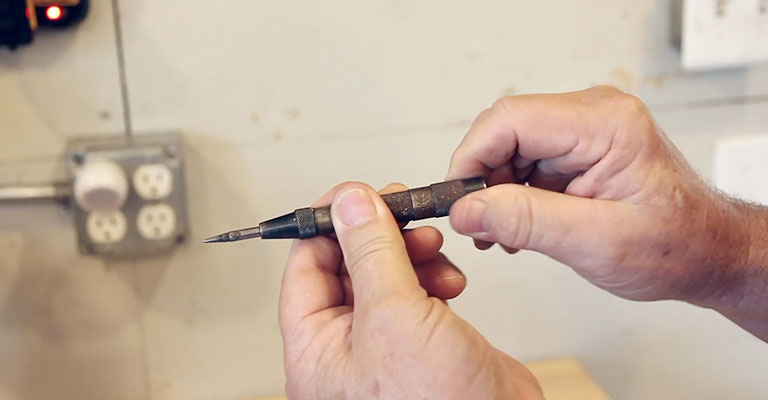
With a pair of scissors, cut out the template from the installation instructions that came with the lockset. Usually, the knob is centered in the horizontal rail that separates the panels, so fold the template around the edge of the door.
Next, make an indentation with the tip of a spade bit in the center of the lockset and barrel hole by taping the template to the door 36 inches off the ground. Once you have made the marks, remove the template.
A barrel hole can be made for a door measuring 1 3/8 inches or a door measuring 1 3/4 inches using the template. Mark the door width with the appropriate mark.
Step 2: Drill The Hole For The Knobs
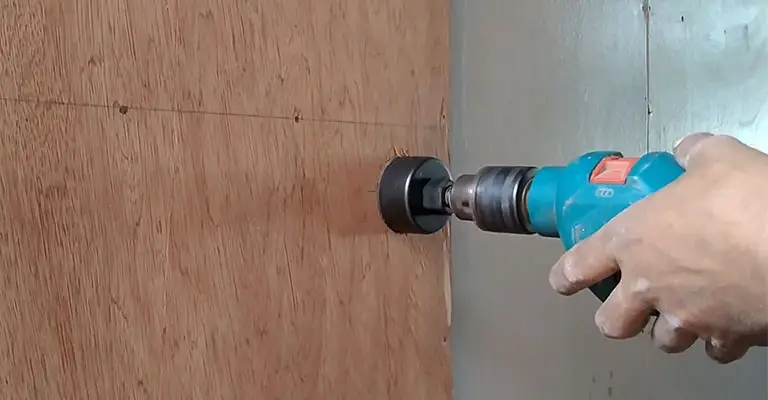
Use a hole saw with a two 1/8 inch diameter to make a mark on the face of the door and place the pilot bit on the mark. Hold the drill steady, so the tip of the pilot bit is visible through the other side of the door as you drill through it.
This side of the door should be used to drill the hole. Following this procedure will ensure that the door’s edges are clean on both sides and that no chips form.
Step 3: Drill The Barrel Hole
Use the appropriate spade bit for the barrel hole according to the instructions. Spade bits should be used for most interior locksets, while spade bits for most exterior locksets should be used for 1-inch locksets.
Next, drill a hole through the larger hole on the face of the door with the spade bit at the mark you made on the edge of the door. Make sure the drill is horizontal and straight as you make this hole.
Step 4: Drill the Strike Hole
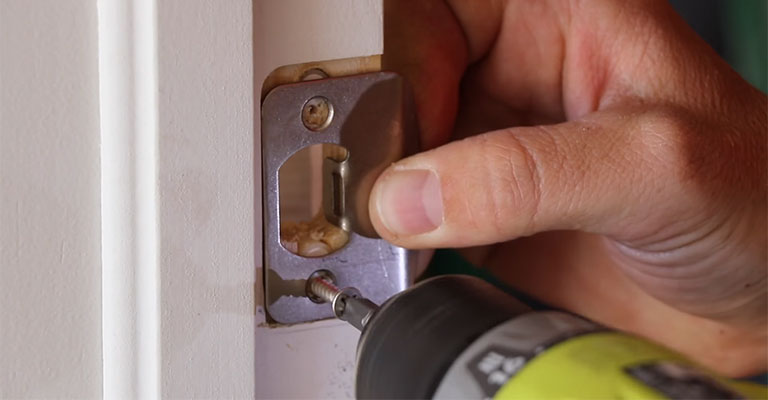
After you’ve installed the lockset, you should make the hole for the door strike. First, the strike position is determined by placing lipstick on the end of the barrel, closing the door, and letting the barrel hit the jamb.
Next, drill approximately 3/4 inches into the jamb with a 7/8-inch bit centered in the mark. The strike must be in position after the hole is drilled, its outline is drawn, and a mortise chiseled so that it can be inset and secured.
Understanding Door Thickness
Residential doors usually measure 1 3/8 inches or 1 3/4 inches thick. The standard thickness of a commercial door is 1 3/4 inches. Therefore, standard door sets can be fitted without modification if the door’s thickness is measured.
There is a possibility that standard door sets will not fit old houses with thinner doors. Therefore, thicker door kits are required for newer homes with custom doors.
How To Measure The Door’s Thickness?
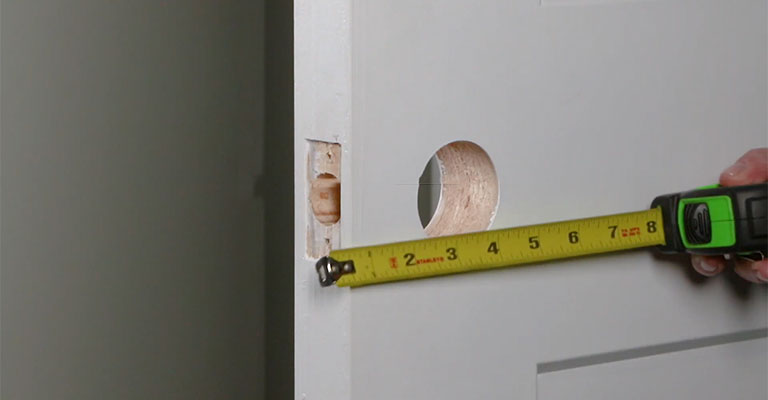
Today, standard doors come in sizes ranging from 1 3/4″ to 1 3/8″ thick and can go up to 2″. Most door frames can accommodate doors of this thickness and measuring them is also fairly straightforward.
Even though it is unlikely that your door frame would accept a thicker or thinner door, it is a good idea to measure the door before you buy it to ensure it fits into the frame correctly.
To determine the thickness of the door, place one end of your measuring tape along one edge and extend it to the other end. Use the tape markings on each side to get the most accurate thickness measurement.
Understanding Bore Holes
Boreholes are found indoors in two types: cross bores and latch bores. It’s where the actual door knob is installed and inserted into the cross bore, which is the largest hole in the door.
Latches are attached to doors by small holes called latch bores. Boreholes are measured to be 2 1/8 inches, and cross bores are measured to be 1 inch in diameter.
For doors that already have a borehole, ensure that the back plate or rosette will fit this hole. It will not fit if the borehole diameter is greater than the diameter of the rosette or backplate.
How To Measure The Doorknob Hole?
Another relatively simple task is measuring the doorknob hole. To get an accurate measurement, you must measure the diameter of the doorknob hole with the doorknob off.
Use your measuring tape to measure the distance between either end of the widest point on the doorknob hole, usually right across the center. There is a standard hole diameter of 2 1/8″ for doorknobs.
You have a typical, standard doorknob hole if this is what you see; if it’s smaller, you most likely have an older door and may need to enlarge it.
What Size Is the Door Knob Hole?
There is usually only one borehole in the prep of interior doors. Normally, the hole size for the borehole is 2 1/8″. There is a 1-inch cross bore that extends through the hole through the edge of the door.
Doorknobs Vs. Door Handles
The purpose of doorknobs and handles is the same: to provide a lever and point of contact for opening and closing doors.
Doorknobs often come in variants designed for older doors, which are more compatible with rim locks because of their leverage and design.
Since door handles don’t have leverage, the knuckles shouldn’t scrape the door surface when opening and closing them, and doorknobs should be mounted a little back.
Now that you know how to ensure your doorknob fits appropriately, you can decide what type of look and feel you want.
Are Doorknob Sizes Universal?
The vast majority of modern doorknobs can be installed on most standard doors, but this is not a universal law, which means you must measure the borehole, backset, and thickness of your door before installing the doorknob.
Older doors will have different doorknob sizes than newer doors, so the fit between the doorknob and the door will differ. Depending on the door type, there may also be a difference in the size of doorknobs on indoor and outdoor doors.
Whether a doorknob will fit a door is determined not by its exterior appearance but rather by its internal characteristics.
Final Words
It is usually a matter of taking out the old doorknob and replacing it with a new one when changing an existing doorknob or fitting a new one.
Nevertheless, there may be a complication with this project, which may be the size of the doorknob hole in this case.
Most modern doors will have a 2 1/8″ diameter hole for door knobs. Generally, older doors have a smaller doorknob hole, so if you want to use a modern doorknob on an older door, you may have to rebore it.
You should also know how to accurately measure the hole size for the doorknob and the thickness of the door and backset so that you can mark, drill, and install the new doorknob and backset without too much difficulty.






